Many herpetologists are drawn to the reptile class because of the most intriguing group of animals: snakes. From their limbless bodies to their unique adaptations, they are alluring.
The diet of the snakes primarily contains eggs, snails, amphibians, fish, rodents, small mammals, birds, lizards, etc. Insects also play a major role in the diet of these serpents.
Snakes’ entomophagous lifestyle is essentially a step toward the survival and evolution of these species. Here is the list of these snakes that eat insects that we will discuss in the following article.
12 Snakes That Eat Insects
1. Corn Snake
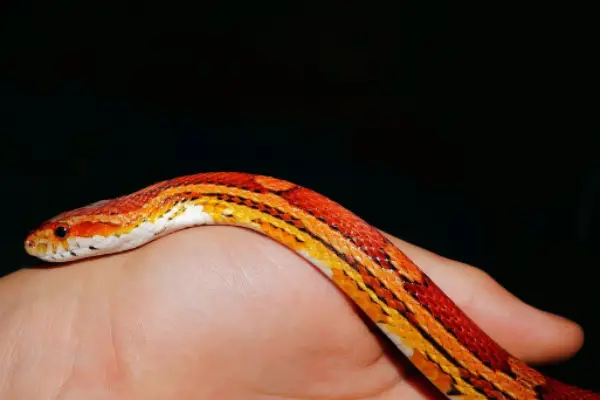
- Scientific Name: Pantherophis guttatus
- Size: 61–182 cm
- Identification: has an orange or red body with yellow spots and black markings
The red rat snake or the corn snake are some of the common names of Pantherophis guttatus.
I read somewhere that people mistakenly believe that they eat corn. Funny, right?
These snakes, in their juvenile phase, eat insects like ants or centipedes. When they grow up, their diet focuses more on rodents, reptiles, amphibians, and bird eggs.
2. Garter Snake
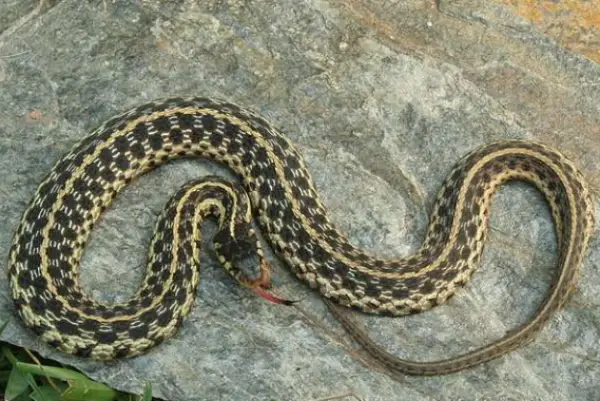
- Scientific Name: Thamnophis
- Size: from 18 to 51 in
- Identification: Have yellow or white stripes on their brown bodies
This native of North America is dispersed throughout the region based on its habitats and eating preferences.
They generally found their food through their sense of smell, camouflage, and constriction.
These carnivorous species can’t survive only on a whole insect diet; they need some other food as well, like amphibians, fish, rodents, and other snakes.
They effectively interact with one another by utilizing intricate pheromonal communication strategies.
3. Rough Green Snake
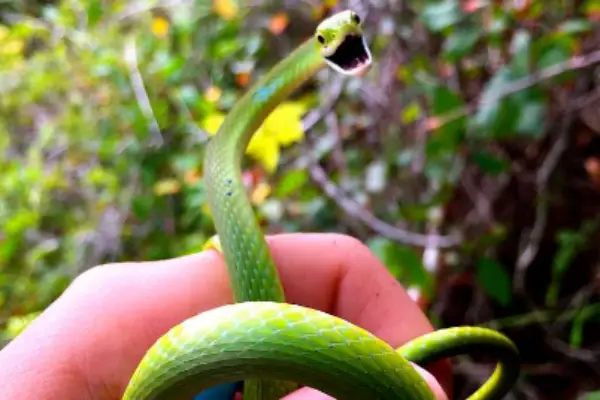
- Scientific Name: Opheodrys aestivus
- Size: up to 116 cm
- Identification: Have bright green body with yellow underside
Opheodrys aestivus is commonly called a rough green snake, a grass snake, or a green grass snake. You can spot these creatures all around the Southern United States, inhabiting moist meadows and woodlands.
They neither use venom nor constriction to kill their prey; they directly swallow them.
Their diet mainly consists of insects and other invertebrates like crickets, grasshoppers, caterpillars, spiders, snails, and slugs. They use some chemosensory techniques to capture their insect prey.
4. Flowerpot Snake
- Scientific Name: Indotyphlops braminus
- Size: 4.4–6.5 inches
- Identification: Have a black or brown shiny color with a blunt head.
These flowerpot snakes are found everywhere on earth except Antarctica. Flowerpot snake, Common blind snake, Teliya snake, Hawaiian blind snake—these are some common names by which people know Indotyphlops braminus.
With a size of 4.4 to 6.5 inches, these snakes are the smallest known snakes in the world, are blind, and can only detect light.
People often mistake them for earthworms due to their coloration and similar burrowing habits.
They primarily feed on pupae, or the eggs of an ant, and also on earthworms, caterpillars, crickets, insect eggs, etc.
5. Milk Snake
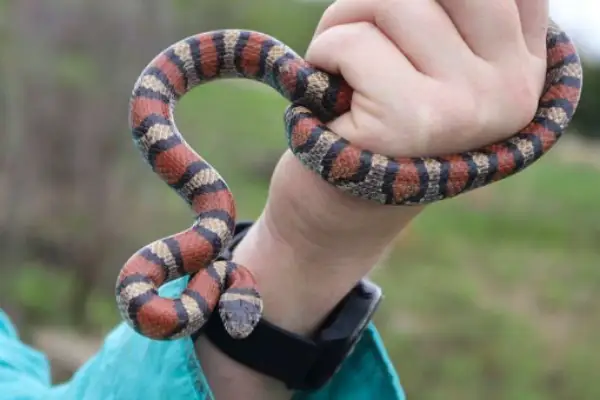
- Scientific Name: Lampropeltis triangulum
- Size: 24 to 36 inches
- Identification
These non-venomous kingsnakes exist in so many distinctive colors, like red, black, orange, etc. As they are kingsnakes, they primarily feed on other snakes, or sometimes on mice or amphibians.
In the early stages of their lives, they are more inclined toward diets that contain bugs like caterpillars, insects, etc.; they show similar coloration to corn snakes, which gives them a survival advantage.
They crush their victims to the very core and are regarded as the strongest constrictors in the snake kingdom.
6. Smooth Green Snake
- Scientific Name: Opheodrys vernalis
- Size: 36–51 cm
- Identification: Has smooth dorsal scales with a light green color
The smooth green snake is a non-venomous snake with a light green color and a white or yellow underside.
You must be wondering why they are called smooth green snakes, as in appearance they are similar to rough green snakes. It is due to the fact that they have smooth dorsal scales present on their body.
Talking about their diet, it mostly includes insects and spiders, including spineless caterpillars, harvestmen, crickets, beetle larvae, moths, ants, snails, worms, and slugs.
7. Ring-neck snake
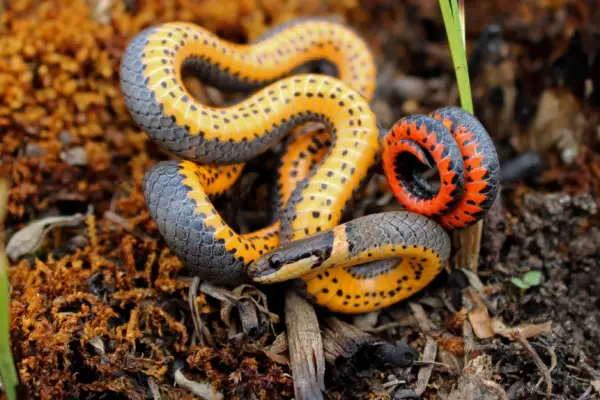
- Scientific Name: Diadophis punctatus
- Size: 10–15 in. (25–38 cm)
- Identification: Have a yellow or orange ring-like structure around the neck
Known as ring-neck snakes, they have a yellow or orange ring around their neck with an orange or yellow underside.
They curl up their tails and expose their bright-colored sides when they feel threatened.
You can find them in North America, inhabiting marshes, meadows, and open woods.
Bugs play a major role in their diet, like slugs, insects, insect larvae, small reptiles, and earthworms.
8. Juvenile Pythons
- Scientific Name: Python
- Size: 23 inches to 33 feet
- Identification: Have a triangular head which is distinct from the neck
We have covered a lot of python species in our other articles; these snakes exist in so many different forms with so many patterns, like blotches, stripes, or a combination of both.
You must know that these snakes have the ability to engulf large animals like lizards, monkeys, pigs, and even crocodiles.
However their juvenile forms do not have such ability; they usually feed on bugs like insects, caterpillars, beetles, etc.
9. Juvenile Rosy Boa
- Scientific Name: Lichanura trivirgata
- Size: 43–112 cm
- Identification: Have three colored longitudinal stripes
Adult rosy boas are mostly into small animals like lizards, amphibians, other snakes, birds, small mammals, etc.
They don’t spend their time worrying about little creatures like bugs.
However, these tiny insects, such as centipedes, are more appealing to their juvenile versions.
You will undoubtedly be amazed by their amazing force while attacking their prey.
10. Southeastern Crowned Snake
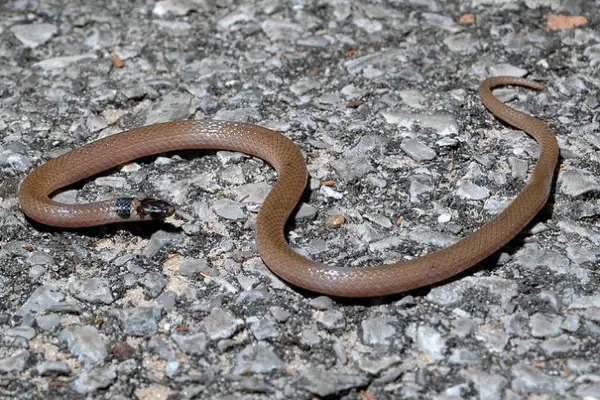
- Scientific Name: Tantilla coronata
- Size: 20–25 cm (8–10 inches)
- Identification: Have black pointed head with yellowish band around their neck
This Colubridae family snake is endemic to the Southeastern United States, inhabiting both damp and dry woodland habitats.
These diurnal snakes are skilled burrowers that appear to swim in sand while burrowing.
These animals are mostly carnivorous, preferring to devour tiny prey such as termites, worms, centipedes, earth-dwelling insect larvae, and spiders.
11. Sharp-tailed snake
- Scientific Name: Contia tenuis
- Size: 12 to 19 inches
- Identification: Have a characteristic sharp pointed tail
Sharp-tailed snake, brown snake, gentle brown snake, Oregon worm snake, Pacific brown snake, Pacific ground snake, and purple-tailed snake are some of the common names of Contia tenuis.
These reticent and reclusive animals can be found in British Columbia and the Western United States.
They can only eat snails and their allied organisms. but is also capable of eating earthworms and insects.
12. Common Coral Snake
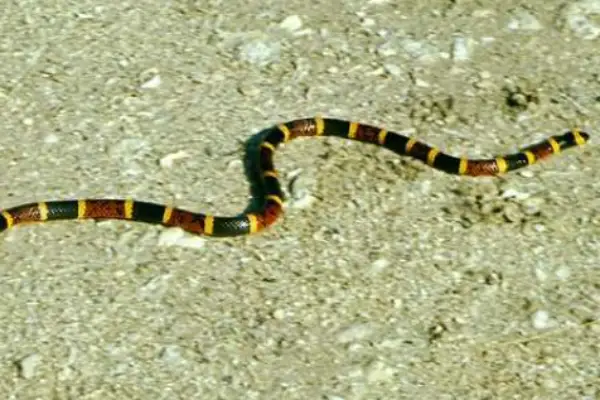
- Scientific Name: Micrurus fulvius
- Size: less than 80 cm (31 in)
- Identification: Have black and red alternate bands all over the body which are separated by a yellow ring
Common coral snakes and Eastern coral snakes are known for their remarkable attacking techniques and venomous nature.
Firstly, they attack their prey’s head and hold it until they get paralyzed.
Their diet primarily includes lizards, birds, frogs, fish, insects, and smaller snakes.
Apart from their tactics, they are known for their incredible coloration.
Our post about snakes that eat bugs comes to an end here. We spoke about the eating patterns of the above-mentioned snakes in this article.
I’m hoping it piques your attention. We’ll be back shortly with another piece.
Also Read:

Being a zoology student I’m always been fascinated toward animals especially insects. I love to do research and learn about different animals. As a writer I want to share my thoughts about nature through my articles. Apart from this you can find me exploring the new places and voice notes.
